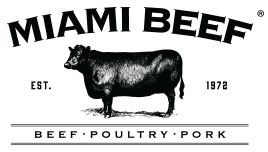Balancing Healthy Restaurant Portions While Keeping Customers Happy
Portion control is an exact science. One of the reasons that fast-food franchises are so successful, is that they have mastered the art of portion control. They can reduce waste by being precise about the execution of preparation, how long it takes to cook each snack or entrée, and you can count on the same portion size in fast-food chains, no matter which location you visit.
Portion control is the most important aspect (beyond promotion) to your profit margin as a restaurant owner. Not only do consumers care about the value they are receiving for the price they are paying for your food (and expect consistency), but it impacts inventory costs as well.
Miami Beef® has earned a reputation for quality, food safety and excellent customer service as a family owned meat processor, for almost 100 years. Our long-term relationships with food service providers (from fast-food franchises to fast-casual restaurants and independent dining establishments) has allowed us to develop state-of-the-art portion control.
We’d like to share some tips and considerations for restaurant owners, hotel and hospitality, and institutional food providers such as educational organizations, to demonstrate how costs can be controlled (without reducing quality) with food portion control.
Quality vs. Quantity: An Important Shift is Happening Again in Food Service
Portion sizes in the United States are starting to undergo another revolution, that is being led by consumers who want to prioritize their health. To demonstrate how much portion sizes have changed in the United States in the past 60 years, you have to take a look back to what a reasonable portion size was a home, and at restaurants for American consumers.
Every aspect of food service and manufacturing has been super-sized in the last few decades. To illustrate what those changes look like, and how they have contributed to unhealthy eating habits and obesity, check out some of these interesting examples:
- Hamburgers are now 23% larger
- American dinnerware plates used to be 6” in diameter. Today, they average between 10” to an oversized 12” plate.
- Mexican food servings are 27% larger per entrée
- Soft drink serving sizes at restaurants are now 52% bigger
- Dried snack servings (chips, popcorn, pretzels) are 60% larger
- Bagels used to be 3” in diameter and about 140 calories. Today, they have doubled to an average of 6” in diameter and 360 calories per serving.
In fact, according to researchers at University of North Carolina at Chapel Hill, the only food type that hasn’t grown significantly in serving size is the pizza. But if you have every had a Chicago or authentic New York slice, you might beg to differ.
As the food service industry began charging more for fast-food or dine-in meals, they felt pressure to add value for the customer, by increasing the quantity of food that was being provided. This is where consumers first began to expect large portions of food, for a reasonable price, and measure their satisfaction with the restaurant based on portion sizes.
The most important conversation left out in that shift in consumer preference, was quality. For instance, if the proteins on the plate (which are healthier but less cost effective for the restaurant) are small in terms of portion size, restaurants learned to compensate by adding economical side dishes. That’s how we ended up at a junction where up to 50% of a plate in a fast-food or fast-casual diner or restaurant can be French fries. They are low cost, fast to prepare, and visually appealing to the customer because they fill a bulk area on the plate to increase perceived value.
The complicated relationship with ‘portion distortion’ followed, and large portions became almost competitively necessary for restaurants to survive. It inadvertently created an unintended impact on consumers; it increased both portion expectation and the amount of food that Americans began to consume daily.
Because we are all more aware today than ever before, about the health consequences and risks of obesity and high-carbohydrate diets, there is an important shift starting that returns to our moderate portion habits of the 60’s and 70’s. Health conscious consumers value quality, instead of quantity. They are nutritionally focused at home and make the same choices when they dine out. They can actually be deterred by huge portion sizes (particularly of low nutritional value foods like potatoes, rice or bread).
How Restaurants Can Make the Switch to Quality Ingredients and Healthy Portion Sizes
Every profitable and successful restaurant kitchen we know, has a quality food scale right in the middle of the preparation area. Portion control during ingredient preparation is critical to ensure the same consistent presentation for customers by menu item. It also means consistent preparation and cooking time, and quality control that helps protect the profit margin for every entrée or appetizer served.
If you are planning a menu, consider that moderation is actually a marketable benefit for these health minded customers. Provide the nutritional information on the menu or on-table kiosk, to help your customers make informed decisions. Remind them of recommended portion sizes and which menu items adhere to healthy serving size guidelines.
Your wholesale meat supplier is an important part of your portion control and profitability strategy as a food service provider or restaurant owner. Learn more about the steps we take at Miami Beef® to ensure the quality and consistency of the wholesale meat we provide our commercial customers, and contact us to learn more about national and international supply services we offer.

